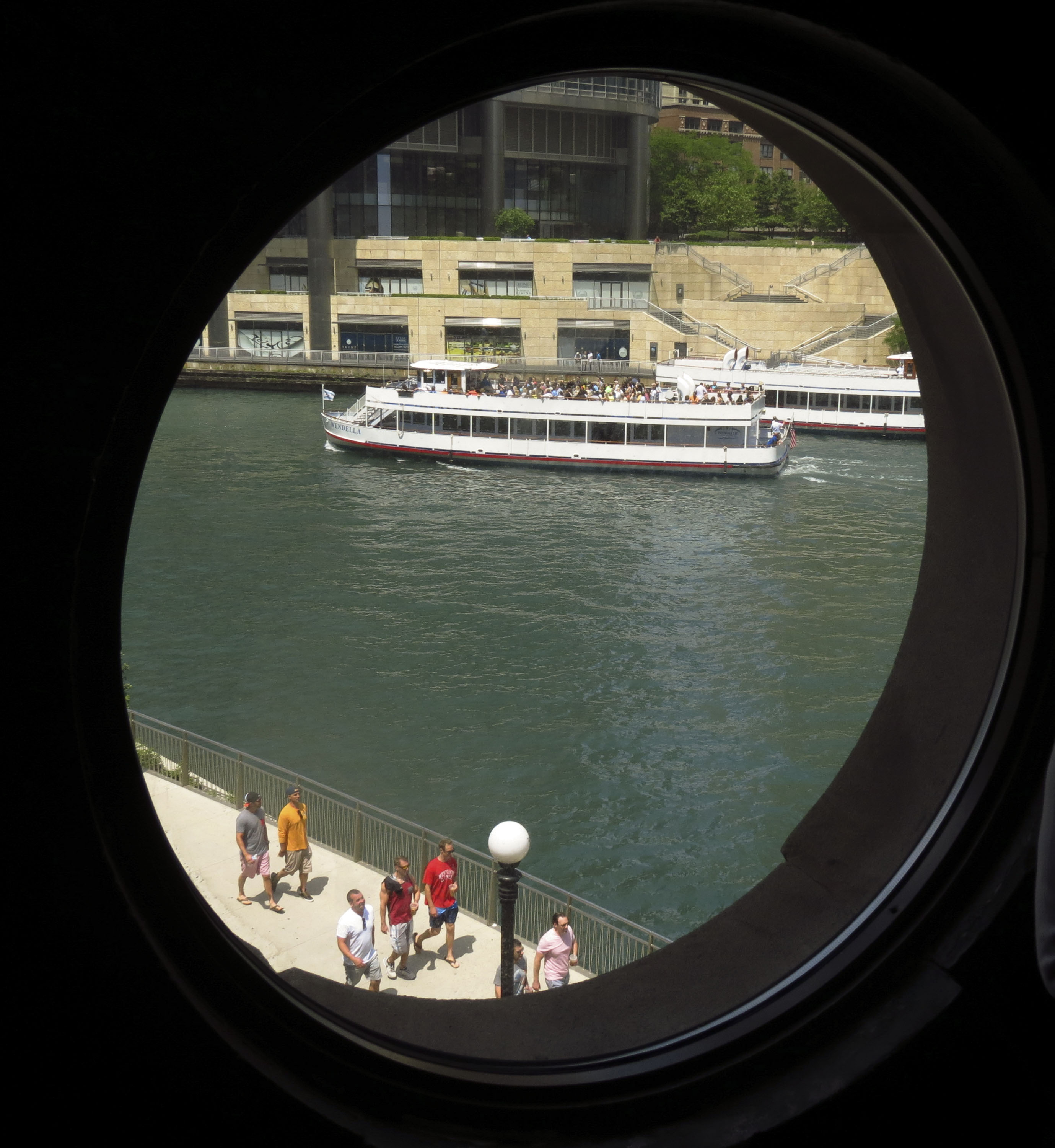 A sightseeing boat cruises on the Chicago River past the Michigan Avenue Bridge. On July 24, 1915, the SS Eastland steamship rolled over in the river, killing 844 people. On hundred years later, there is a renewed interest in the history of the tragedy. DePaul experts are available to discuss the disaster and its implications for Chicago’s marine passenger transportation, immigrant population and labor movement. (Photo by Jamie Moncrief)CHICAGO — One hundred years ago, 844 people were killed during the Eastland disaster when a steamship tipped over in the Chicago River. The SS Eastland steamship was chartered July 24, 1915 by the Western Electric Company for a pleasure cruise to Michigan City, Indiana, and many of those killed were the company’s employees and their relatives.
A sightseeing boat cruises on the Chicago River past the Michigan Avenue Bridge. On July 24, 1915, the SS Eastland steamship rolled over in the river, killing 844 people. On hundred years later, there is a renewed interest in the history of the tragedy. DePaul experts are available to discuss the disaster and its implications for Chicago’s marine passenger transportation, immigrant population and labor movement. (Photo by Jamie Moncrief)CHICAGO — One hundred years ago, 844 people were killed during the Eastland disaster when a steamship tipped over in the Chicago River. The SS Eastland steamship was chartered July 24, 1915 by the Western Electric Company for a pleasure cruise to Michigan City, Indiana, and many of those killed were the company’s employees and their relatives.
DePaul University experts are available to discuss the disaster and its implications for Chicago’s marine passenger transportation, immigrant population and labor movement.
Joseph Schwieterman, professor and director of the Chaddick Institute for Metropolitan Development. Schwieterman can discuss the history of steamship travel in Chicago, which he said began to unravel a few years after the disaster. His book “Terminal Town: An Illustrated Guide to Chicago’s Airports, Bus Depots, Train Stations, and Steamship Landings 1939-Present” explores the rise and fall of steamships in the city.
"Appreciation for the Eastland tragedy is rapidly growing as more people take an interest in the heritage of the Chicago River,” said Schwieterman. “This disaster spoke to the dangers of river travel the way the Hindenburg accident did to dirigibles.”
Images of the aftermath of the disaster have recently emerged from local archives. "The new images give viewers a full appreciation of the Eastland's awkward design, especially its enormous deck that made the vessel susceptible to tipping as people crowded the side railings," he said.
Today, the Chicago River has reemerged as a nexus for tourists and locals alike, with sightseeing tours and commuter water taxis shuttling people through the city’s main waterways, said Schwieterman. Looking ahead, there is a potential for a resurgence of marine passenger service across Lake Michigan, as well, he noted. Schwieterman can be reached at jschwiet@depaul.edu or 312-362-5732.
Colleen Doody, associate professor of history, College of Liberal Arts and Social Sciences. “The Eastland disaster is especially fascinating because it encapsulates some of the major themes of both early 20th century Chicago and American history — industrialization, immigration, and labor relations,” said Doody. Many of Western Electric’s employees were Czech or Polish, two immigrant groups who were relatively recent arrivals to the Chicago area, according to Doody. They were part of a wave of immigration from southern and Eastern Europe that began in the 1890s and reached its peak in the years from 1900-1914.
She explained that the Western Electric Company, the employer of most of the workers on the Eastland, was one of the largest manufacturing plants in the world and a major innovator in telephone and radio technology. The workers and their families were on the Eastland to attend Western Electric’s annual company outing. “Such corporate paternalism was a typical strategy companies used during this period to strengthen worker loyalty to employers rather than labor unions,” Doody said. She can be reached at cdoody@depaul.edu or 773-325-1553.
###
Media Contact:
Kristin Claes Mathews
kmathew5@depaul.edu
312-241-9856